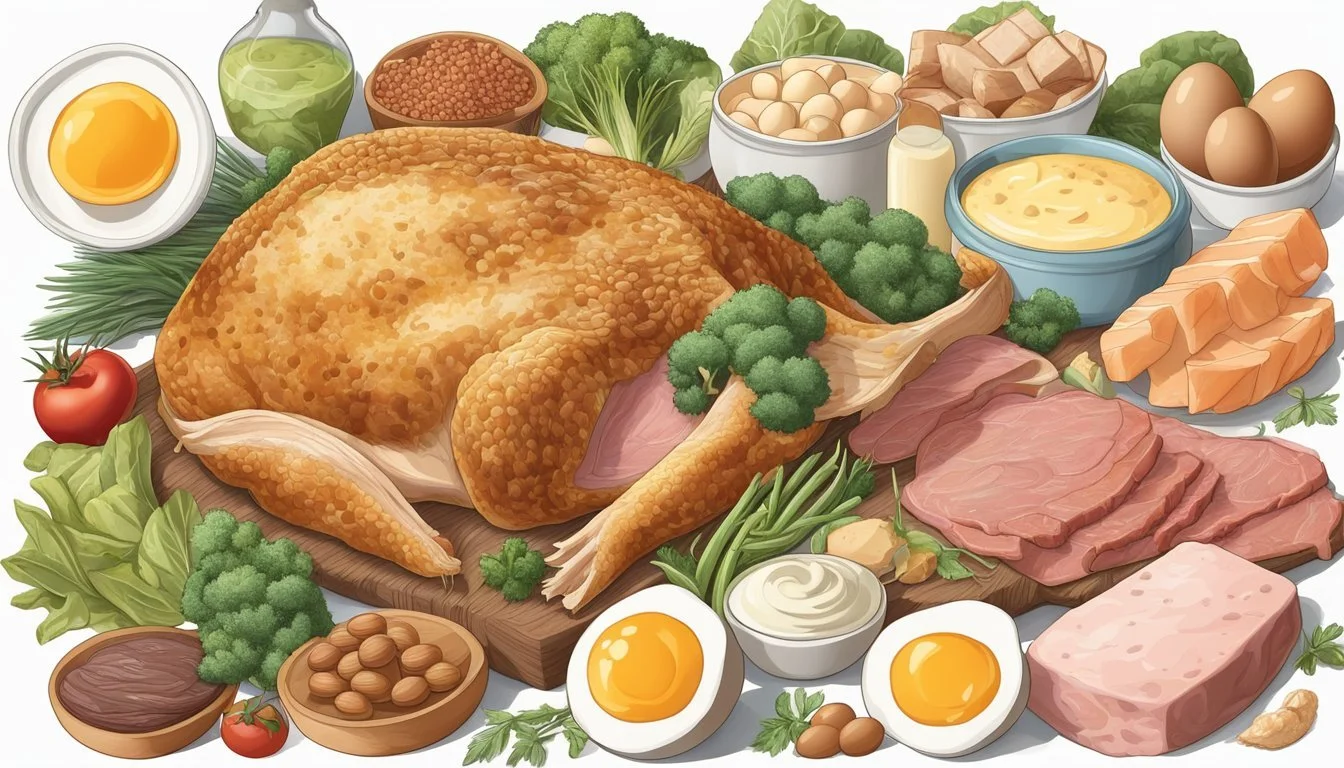Evaluating the Ray Peat Diet
Insights from a Carnivore's Perspective
Exploring different dietary approaches often reveals insights into nutritional science and personal health. The Ray Peat Diet, known for its focus on metabolism-boosting foods, contrasts significantly with the restrictive nature of the Carnivore Diet. This diet prioritizes carbohydrates, fats, and moderate protein intake, which can appeal to those disenchanted with the limitations of strict keto or carnivore regimens.
Ray Peat's dietary philosophy hinges on balancing hormones and insulin levels, which purportedly contributes to better energy and overall health. The diet includes consuming carbohydrates, animal proteins, dairy, liver, root vegetables, and healthy fats, aiming for a well-rounded nutritional intake. While the Carnivore Diet focuses exclusively on animal products, examining Ray Peat's inclusion of varied food groups offers a valuable lens for assessing its potential benefits and downsides.
Acknowledging that the Ray Peat Diet might seem counterintuitive to strict carnivores, its emphasis on metabolic health and energy provision can be compelling. For individuals who struggle with the monotonous nature of the Carnivore Diet, Ray Peat's approach provides an alternative that promises more variety without sacrificing nutritional goals. This broader perspective can be essential for anyone seeking sustainable long-term health and well-being.
What Is the Ray Peat Diet?
The Ray Peat Diet is a nutritional approach developed by Dr. Raymond Peat. It focuses on promoting metabolic health and hormonal balance.
Key principles include the consumption of nutrient-dense, unprocessed foods.
The diet emphasizes carbohydrates from sources such as fruits and simple sugars like honey. These are believed to support thyroid function and provide easily accessible energy. Dairy, particularly whole milk and cheese, is also encouraged due to its proteins, fats, and calcium content.
Meat plays a role in the diet, though red meat is preferred over poultry. It provides essential proteins and minerals such as iron and zinc. Organ meats are particularly valued for their high nutrient density.
In contrast, the diet tends to limit vegetables and fiber due to their potential to irritate the gut and interfere with nutrient absorption. This can be surprising for those used to other health-focused diets that prioritize vegetable intake.
Fats are largely sourced from natural sources. Butter and coconut oil are recommended for their saturated fat content, which is thought to support cellular function and heat production in the body.
The Ray Peat Diet also includes foods rich in vitamins and antioxidants, aiming to reduce oxidative stress and support overall cellular health.
This unique dietary approach aims to provide a well-balanced intake of nutrients to enhance metabolism and improve physical and emotional well-being.
The Carnivore Diet: An Overview
The Carnivore Diet consists solely of animal-based foods. It emphasizes the consumption of meat, animal fats, and other animal-derived products while excluding all plant-based foods.
Core Principles
The fundamental principle of the Carnivore Diet is the exclusive intake of animal products. This includes red meat, poultry, fish, and meats such as bacon or organ meats like liver. Proponents believe this approach aligns with the dietary habits of early humans. Animal fat and high-quality protein are central components.
The diet also implicates a high intake of saturated fats, often found in fatty cuts of meat and animal skins. Bone broth, rich in collagen, is included for its potential benefits for joint and skin health. Eggs and certain dairy products, such as butter and cheese, are sometimes allowed depending on individual tolerance.
Typical Foods Consumed
The Carnivore Diet's menu consists of various animal products. Red meat such as beef, lamb, and pork forms the core. Additionally, poultry like chicken and turkey is common. Fish and shellfish provide essential omega-3 fatty acids. Eggs offer a versatile and nutrient-dense option.
Dairy products, primarily high-fat choices like butter and cheese, are sometimes included if tolerated. Organ meats, such as liver, pack a nutrient punch with vitamins and minerals not as prevalent in muscle meats. Bone broth is prized for its gelatin content. Bacon and sausage can add variety and flavor, ensuring adherents get a well-rounded intake of animal fats and proteins to maintain energy and health.
Nutritional Analysis
The Ray Peat Diet emphasizes a mix of fats, carbs, and proteins aimed at boosting metabolic health. This approach contrasts with the carnivore diet's focus on meat, providing insights into distinct nutritional benefits and drawbacks.
Macronutrients and Micronutrients
Macronutrients:
The Ray Peat Diet allocates a significant portion to carbohydrates and fats, with protein being less emphasized. Typical foods include fruits, dairy products, and occasional muscle meats. For instance, a serving of fresh orange juice provides a substantial amount of carbs, while items like organic vanilla ice cream offer a balanced mix of fats and carbs.
Micronutrients:
This diet integrates various vitamin-rich and mineral-rich foods. Dairy products contribute calcium; fruits like oranges provide Vitamin C. Meats add essential B vitamins and iron. This diversity helps in fulfilling the body's micronutrient requirements, though not all of them.
Potential Nutritional Deficiencies
Following the Ray Peat Diet might lead to some deficiencies, especially if not balanced carefully. The diet's relatively lower focus on vegetables could potentially result in insufficient fiber intake.
Vitamin and Mineral Deficiencies:
Potential gaps include vitamins K and E, primarily found in leafy greens and nuts, which are less emphasized in this diet. Additionally, iron and magnesium intake might vary depending on the specific food choices within the diet.
Protein Considerations:
Although meats and dairy provide some protein, the diet's inclination towards carbs and fats might limit protein-rich food sources, impacting muscle maintenance and repair for those with high protein needs. Users must ensure they include adequate protein to prevent deficiencies.
Maintaining a well-rounded intake of vitamins and minerals is crucial to avoid nutritional gaps. Frequent monitoring and adjusting the diet can help address any deficiencies or excesses.
Get great value for your money by purchasing vitamin K, vitamin E, iron, and magnesium online!
Health Benefits and Risks
The Ray Peat diet targets nutrient-dense, unprocessed foods to optimize hormonal balance and support metabolic functions. These dietary changes can have significant impacts on chronic diseases, weight management, and mental health.
Impact on Chronic Diseases
The Ray Peat diet's emphasis on anti-inflammatory foods like fruits, vegetables, and healthy fats may help reduce inflammation. This reduction is important in managing chronic conditions such as heart disease and diabetes.
By supporting metabolic health and blood sugar regulation, the diet aims to lower the risk of type 2 diabetes and improve heart health. Although not specifically designed to combat cancer, the diet’s focus on nutrient-dense foods may contribute to a lower risk of developing certain cancers. However, a diet high in carbohydrates and sugar could potentially exacerbate issues like high blood pressure if not managed carefully.
Weight Management
Ray Peat’s dietary approach prioritizes balancing hormones, which can positively influence weight management. By emphasizing whole, nutrient-rich foods, individuals may experience better energy levels and an improved metabolic rate.
High carbohydrate intake can be beneficial for someone with a highly active lifestyle or those already lean but may pose a challenge for individuals dealing with obesity or those less active. In these cases, careful monitoring of sugar and fat intake is essential to avoid unintended weight gain.
Mental Health and Mood
The Ray Peat diet can positively impact mental health and mood through its pro-metabolic approach. Nutrient-rich foods that support hormonal balance can lead to improved overall well-being.
By focusing on easily digestible foods, the diet may also help alleviate gastrointestinal discomfort, which can indirectly affect mood. Stable blood sugar levels are crucial for mental clarity and emotional stability, making the diet potentially beneficial for individuals suffering from mood swings or mild depression.
Implementing this diet carefully and paying attention to individual responses can maximize benefits while minimizing any potential risks.
Digestive Health
The Ray Peat Diet offers a unique perspective on digestive health, focusing on specific dietary components that affect gut flora and digestion. It emphasizes the importance of balancing carbohydrates, fats, and moderate protein while avoiding foods that might interfere with metabolic functions.
Effect on Gut Flora
The Ray Peat Diet includes several foods that can influence gut flora. Consuming dairy, eggs, liver, and root vegetables can impact the diversity and health of gut bacteria. These foods are generally low in fermentable fibers, which can reduce the occurrence of bloating and gas produced by bacterial fermentation.
Low fiber intake can be both a benefit and a drawback. On one hand, it may reduce symptoms of irritable bowel syndrome (IBS) such as bloating and discomfort. On the other, fiber is important for maintaining overall colon health and may reduce the risk of colon cancer. Thus, individuals on the Ray Peat Diet might need to monitor their digestive health closely and make adjustments if needed.
Common Digestive Issues
Common digestive issues on the Ray Peat Diet can include constipation due to the lower fiber intake. Since fiber aids in maintaining regular bowel movements, its scarcity in the diet can lead to difficulties in digestion and irregularity.
Another issue can be changes in bloating and digestion. Some individuals may experience reduced bloating due to low fermentable fiber intake, while others may encounter digestive discomfort if their gut flora does not adapt well. Monitoring IBS symptoms is crucial, as some may find relief from the diet’s specific macronutrient balance.
Thus, anyone considering the Ray Peat Diet should carefully observe their digestive responses and consult healthcare providers to ensure their gut health remains optimal.
Comparison with Other Diets
Evaluating the Ray Peat Diet reveals key contrasts with the Ketogenic, Vegan, and Balanced Diet approaches. Below, the distinctions in terms of macronutrient focus, food inclusivity, and health impacts are discussed in detail.
Ketogenic Diet
The Ketogenic Diet, or Keto, emphasizes high fats, moderate proteins, and very low carbohydrates. This contrasts sharply with the Ray Peat Diet, which encourages significant carbohydrate consumption for metabolic energy. While Keto aims to induce ketosis, Ray Peat focuses on maintaining hormonal balance through sugar and carbohydrate intake. Keto often excludes grains, but the Peat Diet includes grains, dairy, and sugar. Both diets allow animal proteins, though the emphasis differs significantly.
Vegan Diet
A Vegan Diet eliminates all animal products, focusing solely on plant-based foods like grains, nuts, legumes, seeds, and vegetables. The Ray Peat Diet, conversely, includes animal products such as dairy, eggs, and liver. Macronutrients differ too, as Vegan diets typically contain higher protein sources from plants. The Peat Diet emphasizes carbohydrates and fats more heavily. Additionally, potential protein sufficiency may be a concern in the Ray Peat Diet due to its moderate protein intake.
Balanced Diet Approaches
Balanced Diet Approaches advocate for a variety of foods from all food groups, promoting vegetables, grains, proteins, and fats evenly. The Ray Peat Diet, while encouraging unprocessed and nutrient-dense foods, places less emphasis on balance. It prioritizes carbohydrates and fats over proteins. Grains are included generously in balanced diets, and the Peat Diet's stance aligns with this. Differences emerge in the inclusion of sugars and specific dairy products, which are more prominent in the Ray Peat Diet. Overall nutritional balance in the traditional sense may be less structured compared to balanced diets.
Public Figures and Advocates
The Ray Peat Diet and the Carnivore Diet both fall under the umbrella of alternative nutritional approaches. Various public figures have spoken about these diets, often sharing personal experiences and insights.
Dr. Shawn Baker
Dr. Shawn Baker is one of the leading advocates of the Carnivore Diet. As an orthopedic surgeon and an athlete, he emphasizes eating primarily meat for optimal health and performance. Baker argues that meat provides all essential nutrients needed without the complications caused by plant-based foods.
He is vocal about the benefits of high protein and fat intake for improving metabolic health, reducing inflammation, and enhancing athletic performance. Through social media and public appearances, he has shared his own health improvements, which include increased energy levels and muscle mass.
Moreover, Baker points to traditional meat-eating populations, such as the Maasai, as evidence of the health benefits associated with a meat-centric diet. His influence extends through books and podcasts, including discussions on shows like Joe Rogan’s podcast.
Joe Rogan
Joe Rogan, a well-known comedian and podcast host, has brought considerable attention to various dietary approaches, including the Carnivore Diet and aspects of the Ray Peat Diet. Rogan's interest in health and fitness has led him to experiment with and discuss different diets on his popular show, "The Joe Rogan Experience."
Rogan has shared personal experiences and hosted numerous experts to discuss the benefits and drawbacks of these diets. His discussions often highlight meat eating and its impact on health markers such as energy, inflammation, and weight management.
By incorporating detailed accounts of his own diet trials and including various guest perspectives, Rogan provides a platform for debating and exploring the practical applications of these nutritional theories. His influence has helped bring mainstream attention to these diets, encouraging broader public engagement and curiosity.
Practical Considerations
Proper planning and consulting professionals are critical for anyone considering the Ray Peat Diet, especially for those transitioning from a carnivore diet.
Designing a Diet Plan
A key aspect of the Ray Peat Diet involves creating a balanced diet plan that incorporates the recommended foods while maintaining metabolic health. To ensure a successful transition, individuals should emphasize nutrient-dense foods like dairy, eggs, liver, root vegetables, and sugars from fruits and honey.
Maintaining a balance between carbohydrates, fats, and proteins is fundamental. Here is an example of a daily meal plan:
Meal Food Items Breakfast Eggs, orange juice, whole milk Lunch Beef liver, root vegetables Dinner Fish, potatoes, fruit dessert Snacks Cheese, yogurt, fresh fruits
It's crucial to avoid inflammatory foods and substances that could hinder metabolic function. This diet recommends restricting polyunsaturated fats and emphasizing saturated fats where possible.
Consulting Healthcare Providers
Before starting the Ray Peat Diet, it is important to consult healthcare providers. A registered dietitian or a physician can provide personalized guidance tailored to an individual's current health status and dietary needs.
For those with preexisting conditions or undergoing medical treatments, professional advice ensures the diet modifications won't interfere with their health. Regular check-ins with healthcare providers can monitor progress and address any issues.
A professional can also recommend nutrient supplements if the diet lacks certain vitamins or minerals. Consulting with a healthcare provider reduces risks and supports a healthy transition into the Ray Peat Diet.
Personal Health and Diet Customization
Personal health greatly influences dietary choices, especially for those with specific medical conditions. It is crucial to tailor diets to individual needs to manage autoimmune conditions and food allergies or sensitivities effectively.
Autoimmune Conditions
Autoimmune conditions, such as Hashimoto's thyroiditis and rheumatoid arthritis, can significantly impact dietary choices. Individuals with these conditions often experience chronic inflammation and may benefit from diets that reduce inflammatory triggers.
The Ray Peat diet emphasizes nutrient-dense foods, such as dairy and root vegetables, that can help support metabolic functions. Including foods rich in iodine and selenium is vital for thyroid health, which is beneficial for autoimmune thyroid conditions.
Managing stress is also crucial for autoimmune conditions, as stress can exacerbate symptoms. The Ray Peat diet suggests consuming coconut oil and other fats to support thyroid function and reduce stress-induced inflammation.
Food Allergies and Sensitivities
Food allergies and sensitivities require careful meal planning to avoid adverse reactions. For example, people with lactose intolerance should choose lactose-free dairy options, while those with gluten sensitivity should avoid wheat products.
The Ray Peat diet allows for a variety of meats, dairy, eggs, and root vegetables, making it easier to avoid common allergens. Foods like liver, which are nutrient-dense, provide essential vitamins and minerals without triggering sensitivities.
Leaky gut syndrome, often associated with food sensitivities, can benefit from the anti-inflammatory nature of the Ray Peat diet. Incorporating foods that promote gut health, such as gelatin and bone broth, helps maintain digestive integrity and reduce symptoms.
Potential Environmental and Ethical Considerations
One of the primary environmental concerns related to the Ray Peat diet is its reliance on animal products such as dairy, eggs, and liver. The production of these foods typically requires significant resources, including land, water, and feed.
Moreover, raising livestock generates greenhouse gases such as methane and contributes to deforestation.
In contrast, plant products generally have a lower environmental impact. Growing fruits, vegetables, and root crops tends to use fewer resources and produces lower greenhouse gas emissions. Therefore, a diet that includes more plant-based foods might be more sustainable.
Ethical considerations arise when evaluating the consumption of animal products. Many people are concerned about animal welfare and the treatment of livestock within industrial farming systems. Ethical questions revolve around the conditions in which animals are raised, including space, diet, and general treatment.
On the other hand, the Ray Peat diet emphasizes nutrient-dense, unprocessed foods. While these foods might promote health, consumers must weigh these benefits against potential ethical and environmental costs.
Processed food generally has negative environmental implications due to the energy-intensive processes involved in production and packaging. While the Ray Peat diet seeks to minimize processed foods, it requires careful consideration of the types of unprocessed foods consumed.
Adopting practices that prioritize sustainable and humane sources of animal products may address some concerns. Making informed choices about where food comes from and how it is produced can lead to environmentally and ethically responsible consumption.
Conclusion
The Ray Peat Diet offers various potential benefits and challenges, especially when compared to a carnivore diet. While emphasizing fats, carbohydrates, and moderate protein, it allows the consumption of diverse foods such as dairy, root vegetables, and liver. This approach contrasts sharply with the stricter animal-based focus of the carnivore diet.
Ray Peat emphasizes a high metabolic rate and balanced hormone function. His diet includes carbohydrates and sugars, which are largely absent in a carnivorous regimen. This inclusion can lead to differing impacts on inflammation, insulin levels, and metabolic health.
Some might find the Ray Peat Diet's broader food choices more appealing. Others could prefer the simplicity and clarity of the carnivore diet. Each approach has unique benefits. The Ray Peat Diet's flexibility versus the carnivore diet's simplicity.
Whether focusing on a pro-metabolic eating plan or strict animal-based nutrition, understanding individual needs and goals is crucial. Each dietary approach offers a distinct path to health, and the best choice depends on personal preferences and health objectives.















